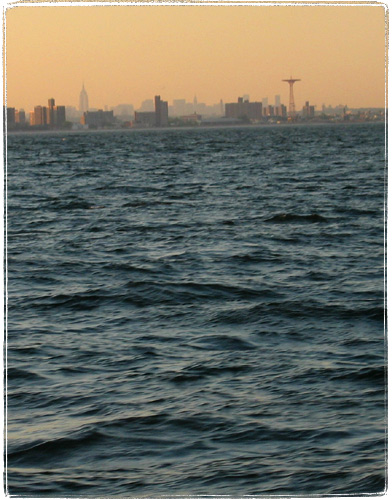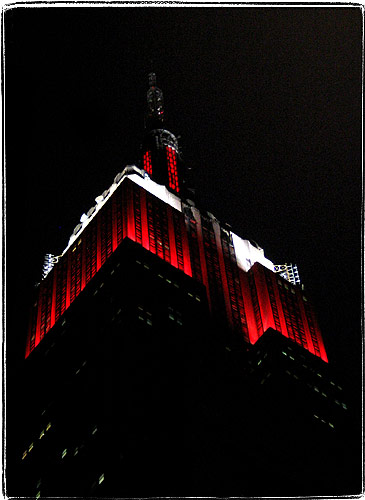

One Hundred Views Of The Empire State Building #7 and #8


One Hundred Views Of the Empire State Building #7 and #8
Only 92 more and I’m done :)


One Hundred Views Of Empire State

So I was buying overpriced fotoclips at the photography museum shop. Then I decided to buy a few postcards for sending to my non-writing friends. The only one New York picture I liked half way was the one on Empire State Building with the subway globe. But then I quickly remembered the globe itself was half a block from where I was. So there it is. Zero creativity, 100% cliche. Saved 75 cents.
Culinary Adventures In K-Town
One of my favorite places to eat out when I feel depressed is the row of Korean restaurants on 32nd street. My life seems to be saturated with tsures lately, so I dragged my wife there on Monday.
That area is known as K-Town, Koreatown or Little Korea even though it’s just one city block (32nd between Broadway and 5th). It’s a very interesting place. Towering over it is the Empire State Building.

The street is composed mostly of traditional Korean restaurants,

gleaming cafes (I wish I could have some bubble tea or other types of the sweet sweet goodness that they sell there)

and other businesses sprinkled in between.
What I usually go for is Korean BBQ. It works like this: you sit at a special table with a fire pit in the middle. The waiter places hot coals into it with a well practiced movement. Every time I see that maneuver I think about how much their insurance must cost them. Then they bring you your choice of raw meat, seafood or vegetables and you proceed to grill it. You also get a ton of little side dishes, souses and very fresh lettuce leaves to wrap your grilled food in.
I really like food wrapped in lettuce. I even thought about opening a little street vendor cart selling lettuce wraps. Lettuce wraps in my opinion are much better than burgers. They are Atkins friendly too.
Korean BBQ is not extremely cheap – expect to pay $15-20 per dish (and even though you don’t get a lot of meat, combined with side dishes and lettuce it’s a filling meal). You also have to order at least two dishes to be seated at the grill table. I highly recommend marinated tongue.
Another unusual food that I tried there is raw beef. It’s very fresh and is served marinated and very cold. Great stuff.
Shaker and Baker or Gaudi, not Gaudy
When I was in my teens, I wanted to become an architect. I read books about architecture, and one of my favorite pastimes was trying to tell the architectural style of any buildings I saw. I did that in my native city of Odessa, Ukraine and on the trips to Moscow, Leningrad and Kiev. For a while I really favored the Gothic style. I really liked the soaring feeling of gothic churches. But then I’ve seen a rather plain building with rounded, yet also soaring shapes. The only decoration on the building were relief plaques. The building was rather old, yet depicted on the plaques were an airplane, a light bulb, a telegraph key and I think a radio. My dad explained to me about Art Deco style.
Here, in America, I learned about different art movements of the beginning of the century. It gets pretty complicated. There is Art Deco, Art Modern, Art Nouveau, Arts and Crafts and Shaker style. Why I like these styles? Well, it’s because I think that they have just the right proportion of beauty and utility. This is a sort of a mental cheat sheet that I have (embellished with links, of course):
Shaker Style: Shakers are a now mostly extinct religious sect. In fact they are a splinter of the Quaker movement, and were called shaking Quakers because their praying during which they shook. I can’t distinguish Shaker Style from Arts and Crafts, and indeed they are very similar. Genuine Shaker items are very expensive, but these days many manufacturers make shaker style furniture and kitchen cabinets. Although great designers and craftsmen, there are very few Shakers remaining. I bet it’s all because they are supposed to be celibate.
Arts and Crafts: Started in Great Britain. A bunch of designers and architects were pissed off by the poor quality and gaudiness of early mass produced things. Their motto was something to the tune of “turn artists into craftsmen and craftsmen into artists”. Simple bordering on austere designs, natural materials, muted colors, handmade look. The radically new idea was to take away most of decoration, but at the same time turn structural elements into decorations. Instead of hiding beams, supports, joins and other elements of construction, the designers would instead show them off. The solidity, strength are considered virtues. The proportions are usually more down to earth, not meant to dwarf a person. Think Frank Lloyd Wright and Newcomb College Pottery. Basically heavy duty, expensive hand made crap for rich people with good taste.
Art Nouveau: Started in France. The name is derived from the name of some gallery or exhibition or something like that. The idea was to create a whole new style for the new century. Just to be different. The designs are organic (meaning that things looked as if they were grown, not built), proportions – elongated. Not a single sharp edge to be seen. Think Aubrey Beardsley, Tiffany (who names their son Louis Comfort?), Gaudi and what he did in Barcelona. I would also call H.R. Ggiger’s stuff modern Art Nouveau, although I don’t know if that’s correct. In general a style for eccentric rich people.
Art Deco: Very similar to Arts and Crafts and Art Nouveau. The major difference is that instead of making things look hand made, the fact that things are made by machines now is celebrated. Elements of the design are very industrial, proportions – soaring. There is a wide variety in colors used – sometimes they are muted, even dark, sometimes – absolutely outrageous. Shining stainless steel is not out of place, and neither is polished black lacquer. Think Chrysler Building, Empire State Building and other New York skyscrapers, early Polaroid cameras, bakelite rotary phones (in fact anything made out of bakelite), cathedral radios, turn of the century cars.
The thing is, Art Deco is easily corrupted. There is a style that is sometimes derogatively referred to as “Bronx Modern” or “Flatbush Renaissance”. Gaudy, ugly stuff. Like much of Italian furniture sold in Brooklyn. Or like Joey Tribbiani’s apartment in “Friends”. Such perverted Art Deco is rather common. Do not confuse it with true, beautiful Art Deco.
Empire State Building Checkmark
Get to the top of the Empire State Building? Check.

The triangle in this picture is formed by my favorite skyscraper of all times — the Flatiron Building.
My fascination with the Flatiron started when I read O.Henry’s “Little Speck in Garnered Fruit” (in Russian translation, of course).
Here is the quote that interested me:
The druggist made an examination. “It isn’t broken,” was his diagnosis, “but you have a bruise there that looks like you’d fallen off the Flatiron twice.”
The translation went something like “your face looked like it was flattened by the Flatiron Building”, but that doesn’t matter.
I’ve never seen a picture of the Flatiron, but reading that story, I tried to imagine what it looked like. Upon seeing the building in Manhattan 5 years later, I instantly realized what it was.
But wait, there is more.
In the first couple of years of the Internet boom I learned about Flatiron Partners, a venture capitalist partnership. At the time I did not even know who venture capitalists were. These guys had a really crappy site though. I wrote them an email, offering to code a better looking website for free, because I liked the Flatiron Building so much. I even got a response, thanking me for my offer, and saying that they were working with some professionals on the new version.
Soon, when I was working at iXL, I actually did some very light coding on their site anyway. iXL was the company that got their account. Talk about destiny, huh? :)
100 Views of the Empire State Building
